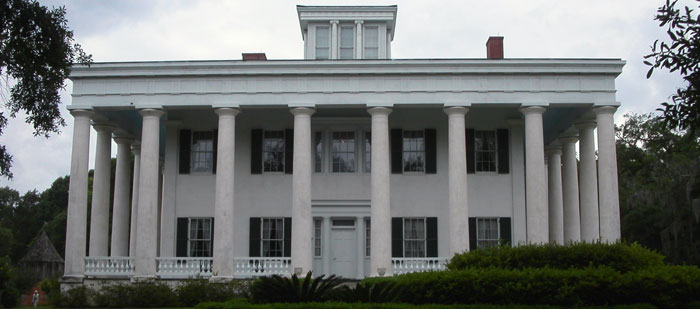
Greenwood, the largest plantation house in the Felicianas, is a restructure. William Ruffin Barrow built the original in 1830 on the 12,000-acre sugar and cotton plantation he purchased from Oliver Pollack, who had acquired the land by grant from the Spanish government. The Barrow family, originally from England, had emigrated first to the Carolinas before settling in the Feliciana country. They prospered in Louisiana, probably building more large plantation homes than any other single family.
Greenwood, with the exception of the twenty-eight brick columns, was built of lath and plaster. The Doric columns, thirty feet tall, rise from an elevated porch to hold a large roof entablature unusually decorated with triglyphs and other designs. Within the four corner columns, roof drains feed below-ground brick cisterns. A belvedere straddles the roof. Originally about forty outbuildings and 100 slave cabins were on the grounds.
Judah P. Benjamin, the noted Confederate statesman and a close friend of Barrow, advised his friend to sell the property because of the approaching Civil War. At a great loss Barrow sold the plantation intact to the Reed family. Federal troops did overrun Greenwood, destroying most of the outbuildings, but sparing the main house for use as a hospital. The Reed family retained the property, living there and maintaining the home until 1906. Greenwood was then sold to Mr. and Mrs. Frank S. Percy, who restored it and eventually opened it to the public.
In 1960 tragedy struck: A huge fire destroyed the house, leaving only the twenty-eight columns standing. Greenwood remained a ruin until 1968 when the charred remains and 300 acres were purchased by Baton Rouge attomey Walton J. Barnes and his son Richard.
The two men then began a most ambitious project: a reconstruction of the house as it originally was. Since no plans existed, the Barneses duplicated the structure by researching hundreds of old photographs and by interviewing those who had visited and lived at Greenwood.
Greenwood once again lives! Its twenty-eight majestic white columns are reflected in the original pool, dug to provide the clay for the columns’ bricks. The interior once again boasts an impressive central hall that is seventy feet long, with a curved wooden stairway at one end. Its furnishings reflect the style of the 1830s. Silver doorknobs and other hardware, ruined in the fire, have been remade.
The house has been used as a locale for several movies. The most notable to date is “North and South,” a televisian miniseries about, a family during the Civil War.
Greenwood is open to the public daily for tours. For more information on the Greenwood Plantation view the Hotel Monteleone listing.
